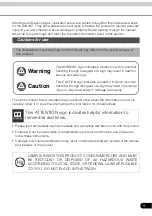
24
4
MEMORY CHANNELS
■
Memory channel programming
Each memory bank (1 to 20) can hold up to 50 channels and
can store the information listed below.
Bank name, memory name, frequency, mode, filter, atten-
uator, tuning step, select memory scan, skip channel, tone
squelch and remark.
D
Using the multi-function receiver screen
q
Click the [BANK
∧
] or [BANK
∨
] button to select a memory
bank to be programmed.
w
Click the [CH
∧
] or [CH
∨
] button to select a memory chan-
nel to be programmed.
e
Set a frequency and mode, etc. that you want to memo-
rize.
r
Click the [MW] button to program the displayed frequency
into the memory channel.
• “NONAME” appears in the memory channel indicator.
D
Using the memory list screen
q
Call up the memory list screen if it is not displayed.
• For the multi-function receiver screen, click the memory list
screen button or select ‘Memory List’ from the [View] menu.
• For the simple function receiver screen, click the [MENU] button
and select the ‘Memory List.’
w
Click [BANK
#
]/[BANK
$
] or select a bank name with [
$
]
to select a memory bank.
e
Click a cell in the [Frequency] column and the desired
memory channel line.
r
Input the receive frequency from the keyboard, then push
[Enter].
• Input frequency first in order for other data to be input.
t
Set other data such as mode, tuning step, etc., if desired.
• Double-click the desired cell, select the desired item and double-
click the selection.
■
Clearing a memory channel
D
Using the multi-function receiver screen
q
Select a desired memory channel to be cleared with
[BANK
∧
]/[BANK
∨
] and [CH
∧
]/[CH
∨
].
w
Click the [MCL] button to clear the memory channel con-
tents.
e
Select desired cell
t
Set other data, if desired
















































